Green iguana
The green iguana (Iguana iguana), also known as the American iguana, is a large, arboreal, mostly herbivorous species of lizard of the genus Iguana. Usually, this animal is simply called the iguana. The green iguana ranges over a large geographic area; it is native from southern Brazil and Paraguay as far north as Mexico, and have been introduced from South America to Puerto Rico and are very common throughout the island, where they are colloquially known as gallina de palo ("bamboo chicken" or "chicken of the trees") and considered an invasive species; in the United States, feral populations also exist in South Florida (including the Florida Keys), Hawaii, the U.S. Virgin Islands and the Rio Grande Valley of Texas.[3][4]
| Green iguana[1] | |
|---|---|
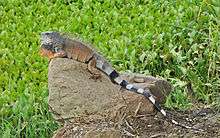 | |
| adult, Ecuador | |
_juvenile.jpg) | |
| juvenile, Grand Cayman | |
| Scientific classification | |
| Kingdom: | Animalia |
| Phylum: | Chordata |
| Class: | Reptilia |
| Order: | Squamata |
| Suborder: | Iguania |
| Family: | Iguanidae |
| Genus: | Iguana |
| Species: | I. iguana |
| Binomial name | |
| Iguana iguana | |
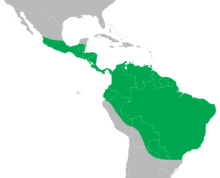 | |
| Synonyms | |
A herbivore, it has adapted significantly with regard to locomotion and osmoregulation as a result of its diet. It grows to 1.5 metres (4.9 ft) in length from head to tail, although a few specimens have grown more than 2 metres (6.6 ft) with bodyweights upward of 20 pounds (9.1 kg).
Commonly found in captivity as a pet due to its calm disposition and bright colors, it can be very demanding to care for properly. Space requirements and the need for special lighting and heat can prove challenging to the hobbyist.

.jpg)
Taxonomy and etymology
The species was first officially described by Swedish botanist Carl Linnaeus in 1758.[5] In the two centuries since then, numerous subspecies have been identified, but later classified as merely regional variants of the same species.[5]
Using nuclear and mitochondrial DNA-sequence data to explore the phylogenic history of the green iguana, scientists from El Salvador, Mexico and the United States studied animals collected from 17 different countries.[6] The topology of phylogeny indicated that the species originated in South America and eventually radiated through Central America and the Caribbean.[6] The study revealed no unique mitochondrial DNA haplotypes for subspecific status, but did indicate the deep lineage divergence between Central and South American populations.[6]
Naturalists once classified the Central American iguanas as a separate subspecies (Iguana iguana rhinolopha), the horned Mexican iguana; however, this classification was later thought to be invalid based on mitochondrial DNA and iguanas with similar nose projections appearing randomly in other populations and interbreeding freely with those that do not share this trait.[7][8] However, genetic studies in the late 2010s recovered I. rhinolopha as a distinct species, along with several other cryptic lineages present in I. iguana. This indicates that only the South American populations may be the "true" green iguana.[9] Two new insular subspecies were also identified in 2019, endemic to St. Lucia and the Grenadines. A 2020 study also recovered both these subspecies as part of a distinct species, the southern Antillean horned iguana (I. insularis). The study also found the Saban black iguana (I. melanoderma), described in that study, to be the sister group of South American I. iguana, with the clade containing both being sister to that of I. insularis.[10]
The word iguana is derived from a Spanish form of the Taíno name for the species: iwana.[11][7] In some Spanish-speaking countries, males of the species are referred to as gorrobo or ministro and juveniles are called iguanita or gorrobito.[12]
Distribution and habitat
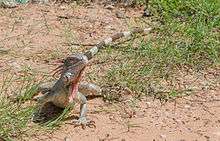
The native range of the green iguana extends from southern Mexico to central Brazil, Paraguay, and Bolivia and the Caribbean; specifically Grenada, Aruba, Curaçao, Trinidad and Tobago, St. Lucia, St. Vincent, and Útila.[13][14] They have been introduced to Grand Cayman, Puerto Rico, Dominican Republic, Texas, Florida, Hawaii, and the U.S. Virgin Islands.[3][4][14][15][16] Furthermore, green iguanas colonised the island of Anguilla in 1995 after being washed ashore following a hurricane.[17] Though the species is not native to Martinique, a small wild colony of released or escaped green iguanas endures at historic Fort Saint Louis.[18]
In South and Central America, where the green iguana is native, it is an endangered species in some countries because people have been hunting and eating this gallino de palo ("bamboo chicken" or "chicken of the trees") for a long time.[19]
Green iguanas are diurnal, arboreal, and are often found near water.[20][8] Agile climbers, Iguana iguana can fall up to 50 feet (15 m) and land unhurt (iguanas use their hind leg claws to clasp leaves and branches to break a fall).[8][21][22] During cold, wet weather, green iguanas prefer to stay on the ground for greater warmth.[12] When swimming, an iguana remains submerged, letting its four legs hang limply against its side. They propel through the water with powerful tail strokes.[12]
While they may often be found in trees, these animals are well-known burrowers. The size of their burrow can range from between 0.3 and 2.4 m deep, with a diameter of 10 to 20 cm.[23] They have been observed burrowing in canals, levees, and dikes and along seawalls in southern Florida. If an individual does not dig their own, they may even use gopher tortoise burrows or usurp those of the Florida burrowing owl.
Anatomy and morphologies
The green iguana is a large lizard and is probably the largest species in the iguana family, though a few in the genus Cyclura may match or exceed it in weight.[24] Adults typically grow to 1.2 to 1.7 m (3.9 to 5.6 ft) in length from head to tail.[7] As in all iguanas, the tail comprises much of this length, and the snout-to-vent length of most green iguanas is 30 to 42 cm (12 to 17 in). An average adult male will weigh around 4 kg (8.8 lb) while the smaller adult female will typically weigh 1.2 to 3 kg (2.6 to 6.6 lb).[25] A few large males can reach or exceed 6 to 8 kg (13 to 18 lb) in weight and 2 m (6.6 ft) long.[26] Some specimens have even reportedly been measured at a body weight of greater than 20 lb (9.1 kg).[7]
Despite their name, green iguanas can come in different colours and types. In southern countries of their range, such as Peru, green iguanas appear bluish in colour with bold blue markings.[8] On islands such as Bonaire, Curaçao, Aruba, and Grenada, a green iguana's colour may range from green to lavender, black, and even reddish brown.[7][8] Green iguanas from the western region of Costa Rica are red, and animals of the northern ranges, such as Mexico, appear orange.[7][8] Juvenile green iguanas from El Salvador are often bright blue as babies, but they lose this color as they get older.[7]
Adult iguanas found on most of St. Lucia, mainly on the northeastern coast, Louvette and Grand Anse, have many differences from other green iguana populations. They are light green with predominant black stripes. Instead of the typical orange dewlap, the iguanas of St. Lucia have a black dewlap. When compared to the common green iguana, females lay about half the amount of eggs, 25 instead of 50. Scales to the back of their head, near the jawbone, are smaller. Their iris is white or cream, whereas other green iguanas have yellow irises.[27][28]
Green iguanas possess a row of spines along their backs and along their tails, which helps to protect them from predators.[8] Their whip-like tails can be used to deliver painful strikes and like many other lizards, when grabbed by the tail, the iguana can allow it to break, so it can escape and eventually regenerate a new one.[29] In addition, iguanas have a well-developed dewlap, which helps regulate their body temperature.[21] This dewlap is used in courtships and territorial displays.[7][8][30]
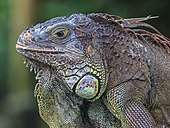
Green iguanas have excellent vision, enabling them to detect shapes and motions at long distances.[31] As green iguanas have only a few rod cells, they have poor vision in low-light conditions. At the same time, they have cells called “double cone cells” that give them sharp color vision and enable them to see ultraviolet wavelengths.[31] This ability is highly useful when basking so the animal can ensure that it absorbs enough sunlight in the forms of UVA and UVB to produce vitamin D.[7][22]
Green iguanas have a white photosensory organ on the top of their heads called the parietal eye (also called the third eye, pineal eye or pineal gland), in contrast to most other lizards that have lost this primitive feature.[31] This "eye" has only a rudimentary retina and lens and cannot form images,[31] but is sensitive to changes in light and dark and can detect movement.[31] This helps the iguana detect predators stalking it from above.[31]
Green iguanas have very sharp teeth that are capable of shredding leaves and even human skin.[7] These teeth are shaped like a leaf, broad and flat, with serrations on the edge. The similarity of these teeth to those of one of the first dinosaurs discovered led to the dinosaur being named Iguanodon, meaning "iguana tooth", and the incorrect assumption that it had resembled a gigantic iguana.[32] The teeth are situated on the inner sides of the jawbones, which is why they are hard to see in smaller specimens.[30]

Primarily herbivorous, green iguanas are presented with a special problem for osmoregulation; plant matter contains more potassium and as it has less nutritional content per gram, more must be eaten to meet metabolic needs.[33] As green iguanas are not capable of creating liquid urine more concentrated than their bodily fluids, like birds they excrete nitrogenous wastes as urate salts through a salt gland.[33] As a result, green iguanas have developed a lateral nasal gland to supplement renal salt secretion by expelling excess potassium and sodium chloride.[33]
Green iguanas from Guatemala and southern Mexico (which may belong to the distinct species I. rhinolopha) predominantly have small horns on their snouts between their eyes and their nostrils, whereas others do not.[8]
Reproductive biology
_juvenile_head.jpg)
Grand Cayman
Male green iguanas have highly developed femoral pores on the underside of their thighs which secrete a scent (females have femoral pores, but they are smaller in comparison to those of the males).[7] In addition, the dorsal spines that run along a green iguana's back are noticeably longer and thicker in males than they are in females, making the animals somewhat sexually dimorphic.[7]
Male green iguanas tend to display more dominant behaviors, such as head bobbing and tail whipping. They also tend to develop a taller dorsal crest than females, as well as taller dorsal spines (or spikes). Large, round, very pronounced jowls are generally a male characteristic. Jowls are located under the jaw and are protected by the subtympanic plate, which is a large, green, circular-shaped scale.
Green iguanas are oviparous, with females laying clutches of 20 to 71 eggs once per year during a synchronized nesting period.[29][34] The female green iguana gives no parental protection after egg laying, apart from defending the nesting burrow during excavation.[34] In Panama, the green iguana has been observed sharing nest sites with American crocodiles and in Honduras with spectacled caimans.[14]
The hatchlings emerge from the nest after 10–15 weeks of incubation.[29][34] Once hatched, the young iguanas look similar to the adults in color and shape, resembling adult females more so than males and lacking dorsal spines.[34]
Juveniles stay in familial groups for the first year of their lives.[34] Male green iguanas in these groups often use their own bodies to shield and protect females from predators and it appears to be the only species of reptile which does this.[35]
Behavior

When frightened by a predator, green iguanas will attempt to flee and, if near a body of water, dive into it and swim away.[12] If cornered by a threat, the green iguana will extend and display the dewlap under its neck, stiffen and puff up its body, hiss, and bob its head at the aggressor.[8] If the threat persists, the iguana can lash with its tail, bite and use its claws in defense.[12] The wounded are more inclined to fight than uninjured prey.[12]
Green iguanas use "head bobs" and dewlaps in a variety of ways in social interactions, such as greeting another iguana or to court a possible mate.[7] The frequency and number of head bobs have particular meanings to other iguanas.[8]
Green iguanas are hunted by predatory birds, and their fear of these is exploited as a ploy to catch them in the wild.[12] A hunter will imitate the sound of a hawk by whistling or screaming, causing the iguana to freeze and making it easier to capture.[12]
Diet
Green iguanas are primarily herbivores, with captives feeding on leaves such as turnip greens, mustard greens, dandelion greens, flowers, fruit, and growing shoots of upwards of 100 different species of plant.[7][34] In Panama, one of the green iguana's favorite foods is the wild plum (Spondias mombin).[12]
Although they will consume a wide variety of foods if offered, green iguanas are naturally herbivorous and require a precise ratio of minerals (2 to 1 calcium to phosphorus) in their diet.[22][36] It is important for captive iguanas to have a variety of leafy greens along with fruits and vegetables such as turnip greens, collards, butternut squash, acorn squash, mango, and parsnip.[37][38] Juvenile iguanas often eat feces from adults in order to acquire the essential microflora to digest their low-quality and hard-to-process vegetarian-only diet.[12][34]
There is some debate as to whether captive green iguanas should be fed animal protein.[7] There is evidence of wild iguanas eating grasshoppers and tree snails, usually as a byproduct of eating plant material.[39][40] Wild adult green iguanas have been observed eating birds' eggs.[13] Zoologists, such as Adam Britton, believe that such a diet containing protein is unhealthy for the animal's digestive system, resulting in severe long-term health damage, including kidney failure and leading to premature death.[41] On the other side of the argument is that green iguanas at the Miami Seaquarium in Key Biscayne, Florida, have been observed eating dead fish and individuals kept in captivity have been known to eat mice without any ill effects.[7] De Vosjoli writes that captive animals have been known to survive and thrive on eating nothing but whole rodent block, or monkey chow, and one instance of romaine lettuce with vitamin and calcium supplements.[7] However, it is only recommended that captive iguanas not be fed lettuce or meat, and instead receive the vitamins and minerals they need via a purely herbivorous diet.
Captivity

The American pet trade has put a great demand on the green iguana; 800,000 iguanas were imported into the U.S. in 1995 alone, primarily originating from captive farming operations based in their native countries (Honduras, El Salvador, Colombia, and Panama).[42] However, these animals are demanding to care for properly over their lifetime, and many die within a few years of acquisition.[7][43]
Although green iguanas in captivity will eat meat if presented with it, excessive consumption of animal protein results in severe kidney problems and possible premature death.[7][41] Misinformed pet owners tend to feed iguanas iceberg lettuce, which provides iguanas with water, but has little nutritional value compared to other vegetables.[22] A captive green iguana's diet should consist of fresh leafy vegetables, such as mustard greens, collard greens, dandelion, arugula, or kale, and access to fresh water.[7]
Green iguanas will thrive only in temperatures of 79 °F (26 °C) to 95 °F (35 °C) and must have appropriate sources of UVB and UVA lighting, or else their bodies cannot produce vitamin D that promotes calcium absorption, which can result in a metabolic bone disease that can be fatal.[7][22] In some locales (such as New York City and Hawaii), iguanas are considered exotic pets, and ownership is prohibited.[44][45] Due to the potential impact of an introduced species on Hawaii's ecosystem, the state has strict regulations regarding the import and possession of green iguanas; violators can spend three years in jail and be fined up to $200,000.[46]
As an invasive species
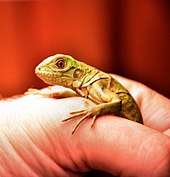

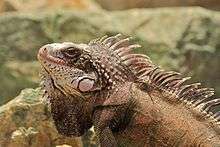
Caribbean
In the aftermath of Hurricane Luis and Hurricane Marilyn in 1995, a raft of uprooted trees carrying 15 or more green iguanas landed on the eastern side of Anguilla – an island where green iguanas had never been recorded before.[47] These iguanas were apparently accidentally caught on the trees and rafted 200 miles across the ocean from Guadeloupe, where green iguanas are indigenous.[17][48] Examination of the weather patterns and ocean currents indicated that the iguanas had probably spent three weeks at sea before arriving on Anguilla.[48] This new colony began breeding on the island within two years of its arrival.[48]
In February 2012, the government of Puerto Rico proposed that the islands' iguanas, which were said to have a population of 4 million and considered to be a non-native nuisance, be eradicated and sold for meat.[49][50]
Fiji
The green iguana is present as an invasive species on some of the islands of Fiji, where it is known as the American iguana. They pose a threat to the native iguanas through the potential spread of disease and to humans by spreading salmonella. They were initially brought to Qamea in 2000 by an American who wanted them to eat the numerous insects on the island, although they are primarily vegetarian. They are now on the islands of Laucala, Matagi and Taveuni.[51][52]
United States
The green iguana is established on Oahu and Maui, Hawaii, as a feral species, despite strict legislation banning the importation of any reptiles,[53][54] and in the Rio Grande Valley of Texas.[8] As most reptiles carry salmonella, this is a concern and a reason legislation has been sought to regulate the trade in green iguanas.[14]
Due to a combination of events, the green iguana is considered an invasive species in South Florida and is found along the east coast, as well as the Gulf Coast, of Florida from Key West to Pinellas County.[14][30][55] The original small populations in the Florida Keys were stowaways on ships carrying fruit from South America.[56] Over the years, other iguanas were introduced into the wild, mostly originating through the pet trade. Some escaped and some were intentionally released by their owners; these iguanas survived and then thrived in their new habitat.[55] They commonly hide in the attics of houses and on beaches. They often destroy gardens and landscaping.[55] They seem to be fond of eating a native endangered plant, Cordia globosa, and feeding on nickernut (Caesalpinia) a primary food plant of the endangered Miami blue butterfly (Cyclargus thomasi bethunebakeri); additionally on Marco Island, green iguanas have been observed using the burrows of the Florida burrowing owl (Athene cunicularia floridana), a species of special concern, all of which can make them more of a serious threat to Florida's ecosystem than originally believed.[14][56]
In January 2008, large numbers of iguanas established in Florida dropped from the trees in which they lived, due to uncommonly cold nights that put them in a state of torpor and caused them to lose their grip on the tree branches.[57] Though no specific numbers were provided by local wildlife officials, local media described the phenomenon as a "frozen iguana shower" in which dozens "littered" local bike paths. Upon the return of daytime warmth, many (but not all) of the iguanas "woke up" and resumed their normal activities.[58] This occurred again in January 2010 and January 2018 after a prolonged cold front once again hit southern Florida.[59][60]
Conservation
The green iguana is listed within Appendix II by CITES, indicating that it is beneficial to regulate trade of this species to ensure that the species does not become threatened.[61][62] In addition, the green iguana is listed as Least Concern by the IUCN, with a mention of habitat depletion from development being a possible concern for green iguana populations in the future.[63][64] Historically, green iguana meat and eggs have been eaten as a source of protein throughout their native range,[65] and are prized for their alleged medicinal and aphrodisiac properties.[64] Efforts to raise green iguanas in the past have been made to raise green iguanas in captivity as a food source in an attempt to encourage more sustainable land use in Panama and Costa Rica.[66]
Cultural references
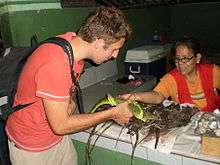
The Moche people of ancient Peru worshipped animals and often depicted green iguanas in their art.[67] The green iguana and its relative the black iguana (Ctenosaura similis) have been used as a food source in Central and South America for the past 7,000 years.[11] It is possible that some of the populations in the Caribbean were translocated there from the mainland by various tribes as a food source.[11] In Central and South America, green iguanas are still used as a source of meat and are often referred to as gallina de palo ("bamboo chicken" or "chicken of the trees"),[12] because they are said to taste like chicken.[68]
References
- "Iguana iguana (Linnaeus, 1758)". Integrated Taxonomic Information System. Retrieved 4 September 2008.
- Bock, B., Malone, CL, Knapp, C., Aparicio, J., Avila-Pires, T.C.S., Cacciali, P., Caicedo, J.R., Chaves, G., Cisneros-Heredia, D.F., Gutiérrez-Cárdenas, P., Lamar, W., Moravec, J., Perez, P., Porras, L.W., Rivas, G., Scott, N., Solórzano, A. & Sunyer, J. (2018). "Iguana iguana". IUCN Red List of Threatened Species. IUCN: e.T174481A1414646. doi:10.2305/IUCN.UK.2018-1.RLTS.T174481A1414646.en.CS1 maint: uses authors parameter (link)
- Falcón, Wilfredo; Ackerman, James D.; Recart, Wilnelia; Daehler, Curtis C. (2013). "Biology and Impacts of Pacific Island Invasive Species. 10. Iguana iguana, the Green Iguana (Squamata: Iguanidae)". Pacific Science. 67 (2): 157–186. doi:10.2984/67.2.2.
- Falcón, Wilfredo; Ackerman, James D.; Recart, Wilnelia; Curtis, Daehler (2012). "March of the green iguana: Non-native distribution and predicted distribution of Iguana iguana (Squamata: Iguanidae) in the Greater Caribbean Region". IRCF Reptiles and Amphibians. 19 (3): 150–160.
- Hollingsworth, Bradford D. (2004), "The Evolution of Iguanas an Overview and a Checklist of Species", Iguanas: Biology and Conservation, University of California Press, pp. 40–41, ISBN 978-0-520-23854-1
- Stephen, Catherine (2006), "Genetic Studies Update", Iguana Journal of the International Iguana Society, 13 (2): 127
- De Vosjoli, Phillipe; Susan Donoghue; Roger Klingenberg; David Blair (2003), The Green Iguana Manual, Advanced Vivarium Systems, ISBN 978-1-882770-67-0
- Samuelson, Phillip (1995-06-01), "The Lizard King", Reptiles Magazine, 3 (2): 64–84, Bibcode:1996SciAm.274f..26M, doi:10.1038/scientificamerican0696-26a
- Breuil, Michel; Vuillaume, Barbara; Schikorski, David; Krauss, Ulrike; Morton, Matthew N.; Haynes, Pius; Daltry, Jennifer C.; Corry, Elizabeth; Gaymes, Glenroy; Gaymes, Joanne; Bech, Nicolas (2019-05-20). "A story of nasal horns: two new subspecies of Iguana Laurenti, 1768 (Squamata, Iguanidae) in Saint Lucia, St Vincent & the Grenadines, and Grenada (southern Lesser Antilles)". Zootaxa. 4608 (2): 201–232. doi:10.11646/zootaxa.4608.2.1. ISSN 1175-5334.
- Stephen, Catherine L.; Reynoso, Víctor H.; Collett, William S.; Hasbun, Carlos R.; Breinholt, Jesse W. (2013). "Geographical structure and cryptic lineages within common green iguanas, Iguana iguana". Journal of Biogeography. 40 (1): 50–62. doi:10.1111/j.1365-2699.2012.02780.x. ISSN 1365-2699.
- Coles, William (2002), "Green Iguana" (PDF), U.S.V.I. Animal Fact Sheet #08, Department of Planning and Natural Resources US Virgin Islands Division of Fish and Wildlife, archived from the original (PDF) on 2007-12-11
- Swanson, Paul L. (1950), "The iguana: Iguana iguana iguana (L)", Herpetologica, 6 (7): 187–193, JSTOR 3890004
- Lazell, J.D. (1973), "The lizard genus Iguana in the Lesser Antilles", Bulletin of the Museum of Comparative Zoology, New York, 145, pp. 1–28
- Krysko, Kenneth L; Enge, Kevin M; Donlan, Ellen M; Seitz, Jason C (2007), "Distribution, Natural History, and Impacts of the Introduced Green Iguana in Florida", Iguana: Conservation, Natural History, and Husbandry of Reptiles, International Reptile Conservation Foundation, 14 (3): 142–151
- Mani, Bina (17 July 2002), Wild Blue Iguanas plummeting towards extinction, retrieved 28 October 2007Scholar search
- Seidel, M; Franz, R (1994), "Amphibians and reptiles (exclusive of marine turtles) of the Cayman Islands", The Cayman Islands: natural history and biogeography, The Netherlands: Kluwer Academic Publishers, pp. 407–434, ISBN 978-0-7923-2462-1
- Censky, E. J.; Hodge, K.; Dudley, J. (1998-10-08). "Over-water dispersal of lizards due to hurricanes". Nature. 395 (6702): 556. Bibcode:1998Natur.395..556C. doi:10.1038/26886.
- Breuil, Michel (2000), "Taxon reports: I. delicatissima and I. iguana" (PDF), West Indian Iguana Specialist Group Newsletter, IUCN, 3 (1): 4–5, retrieved 14 February 2012
- "Eating Invasive Iguanas | The Plate". September 2015. Retrieved 2015-09-05.
- Cogger, Harold; Zweifel, Richard (1992), Reptiles & Amphibians, Sydney, Australia: Weldon Owen, p. 140, ISBN 978-0-8317-2786-4
- Bebler, John L.; King, F. Wayne (1979), The Audubon Society Field Guide to Reptiles and Amphibians of North America, New York: Alfred A. Knopf, pp. 511–512, ISBN 978-0-394-50824-5
- Rosenfeld, Arthur (1989), Exotic Pets, New York: Simon & Schuster, p. 105, ISBN 978-0-671-47654-0
- "Just Green Iguanas?: The Associated Costs and Policy Implications of Exotic Invasive Wildlife in South Florida". May 2020. Retrieved 2020-04-30.
- Green Iguana, Iguana iguana, Giant Green Iguana Facts and Care. Animal-world.com. Retrieved on 2012-08-22.
- Rivas, J.A. (2008). Pers. comm.
- Green Iguana – Iguana iguana : WAZA : World Association of Zoos and Aquariums Archived 2016-05-14 at the Wayback Machine. WAZA. Retrieved on 2012-08-22.
- Jeanette Victor: Forestry Department (2011-12-21). "Alien Invasive Green Iguana; a Threat to Iyanola, St. Lucia's Iguana". Retrieved May 15, 2015.
- "Protecting the St. Lucian Iguana - An endangered species!". Archived from the original on 2016-03-04. Retrieved May 15, 2015.
- Capula, Massimo; John L. Behler (1989), Simon & Schuster's Guide to Reptiles and Amphibians of the World, New York: Simon & Schuster, ISBN 978-0-671-69098-4
- Conant, Roger; Collins, Joseph (1991), A Field Guide to Reptiles and Amphibians Eastern/Central North America, Boston, Massachusetts: Houghton Mifflin Company, pp. 94–95, ISBN 978-0-395-58389-0
- Brames, Henry (2007), "Aspects of Light and Reptile Immunity" (PDF), Iguana: Conservation, Natural History, and Husbandry of Reptiles, International Reptile Conservation Foundation, 14 (1): 19–23
- Norman, David B. (2004), "Basal Iguanodontia", in Weishampel, D.B.; Dodson, P.; Osmólska H. (eds.), The Dinosauria (2nd ed.), Berkeley: University of California Press, pp. 413–437, ISBN 978-0-520-24209-8
- Hazard, Lisa C. (2004), "Sodium and Potassium Secretion by Iguana Salt Glands", Iguanas: Biology and Conservation, University of California Press, pp. 84–85, ISBN 978-0-520-23854-1
- Burghart, Gordon (2004), "Iguana Research: Looking Back and Looking Ahead", Iguanas: Biology and Conservation, University of California Press, pp. 5–10, ISBN 978-0-520-23854-1
- Rivas, Jesus; Levin, Luis E (2004), "Sexually Dimorphic Antipredator Behavior in Juvenile Green Iguanas", Iguanas: Biology and Conservation, University of California Press, p. 121, ISBN 978-0-520-23854-1
- Kaplan, Melissa (2007-04-19). "'MK Diet' – The Short Version". Melissa Kaplan's Herp Care Collection. Retrieved 2007-06-27.
- "Food Information Chart". Green Iguana Society.
- "Food Chart". Iguana Zone.
- Townsend, Josiah H.; John Slapcinsky; Kenneth L. Krysko; Ellen M. Donlan; Elizabeth A. Golden (2005). "Predation of a tree snail Drymaeus multilineatus (Gastropoda: Bulimulidae) by Iguana iguana (Reptilia: Iguanidae) on Key Biscayne, Florida" (PDF). SouthEastern Naturalist. pp. 361–364. Retrieved 2009-08-08.
- Meshaka, Walter; Bartlett, Richard; Smith, Henry (2004). "Colonization success by Green Iguanas in Florida". Iguana: Journal of the International Iguana Society. State Museum of Pennsylvania, Zoology and Botany. 11 (3): 154–161.
- Britton, Adam (2007-04-19). "Animal Protein and Claw Trimming". Melissa Kaplan's Herp Care Collection. Retrieved 2007-06-27.
- "Green Iguana", Reptiles and Amphibians Fact Sheets, National Zoological Park, 2007, archived from the original on 2011-08-19, retrieved 2007-10-28
- Loukopoulos P, Komnenou A, Papadopoulos E, Psychas V (2007), "Lethal Ozolaimus megatyphlon infection in a green iguana (Iguana iguana rhinolopha)", Journal of Zoo and Wildlife Medicine, 38 (1): 131–4, doi:10.1638/2006-0018r.1, PMID 17469289
- Blood, Michael R (1999-06-30), "Exotic Pets' Days Numbered", New York Daily News
- "Green Iguana Society Adoption Board" (discussion board). Archived from the original on 2007-07-07. Retrieved 2007-06-27.
- Iguana & Illegal Lizard Turned In Under Amnesty, State of Hawaii Department of Agriculture, 2002-04-16, archived from the original on 2008-02-28, retrieved 2007-10-28
- Lawrence, E. (1998-10-15). "Iguanas ride the waves". Nature. doi:10.1038/news981015-3.
- Yoon, C. K. (1998-10-08). "Hapless iguanas float away and voyage grips biologists". The New York Times.
- Coto, Damica (February 3, 2012). "Puerto Rico's Iguanas To Be Killed; Meat Will Be Exported". Associated Press. Retrieved February 7, 2012.
- "Puerto Rico, Cayman Islands to cull populations of invasive green iguanas". Green Antilles. 2012-02-06. Archived from the original on 2012-08-04. Retrieved February 7, 2012.
- Thomas, Nunia (2010-04-27). "American iguanas in Fiji". NatureFiji-MareqetiViti. Archived from the original on 2012-05-11. Retrieved 2011-11-13.
- Field, Michael (2011-11-13). "'Aliens' invade Fiji isles|". Sunday Star-Times. Retrieved 2011-11-13.
- Perry, Brian (2006-04-12), "Leaping lizards! Girl sights iguana in Kahului", The Maui News
- Hawaii Dept. of Agriculture News Release – NR09-03, 2009-02-05
- Lush, Tamara (2005-07-26), "Florida's Iguana Infestation", St. Petersburg Times
- Youth, Howard (2005), "Florida's Creeping Crawlers", Zoogoer, 20 (3), archived from the original on 2008-01-01
- Cold Snap Causes Frozen Iguana Shower, WESH, 2008
- "Alien Iguanas Fall From Florida Trees During Cold Snap", Associated Press, National Geographic Society, 2008
- "Cold tightens grip, all the way to Florida iguanas". Associated Press. cleveland.com. January 6, 2010.
- "Iguanas are falling out of trees in Florida because it's so cold. Please don't pick them up". Associated Press. washingtonpost.com. January 4, 2018.
- "Green-iguana2 | CITES". cites.org. Retrieved 2019-05-11.
- "The CITES Appendices | CITES". cites.org. Retrieved 2019-05-11.
- Bock, B., Malone, CL, Knapp, C., Aparicio, J., Avila-Pires, T.C.S., Cacciali, P., Caicedo, J.R., Chaves, G., Cisneros-Heredia, D.F., Gutiérrez-Cárdenas, P., Lamar, W., Moravec, J., Perez, P., Porras, L.W., Rivas, G., Scott, N., Solórzano, A. & Sunyer, J. 2018. Iguana iguana. The IUCN Red List of Threatened Species 2018: e.T174481A1414646. http://dx.doi.org/10.2305/IUCN.UK.2018-1.RLTS.T174481A1414646.en. Downloaded on 10 May 2019.
- "Survey of Status, Trade, and Exploitation of Central American Iguanas". ResearchGate. Retrieved 2019-05-11.
- García-Quijano, Carlos G.; Carlo, Tomás A.; Arce-Nazario, Javier (2011). "Human Ecology of a Species Introduction: Interactions Between Humans and Introduced Green Iguanas in a Puerto Rican Urban Estuary". Human Organization. 70 (2): 164–178. doi:10.17730/humo.70.2.p24755p02826h047. ISSN 0018-7259. JSTOR 44150988.
- "Iguana iguana. The IUCN Red List of Threatened Species". ResearchGate. Retrieved 2019-05-11.
- Berrin, Katherine & Larco Museum. The Spirit of Ancient Peru:Treasures from the Museo Arqueológico Rafael Larco Herrera. New York: Thames & Hudson, 1997.
- Gruson, Lindsey (22 August 1989). "A Plan to Save Iguanas, and Rain Forests in the Bargain". The New York Times. Retrieved 17 July 2008.
External links
| Wikispecies has information related to Iguana iguana |
| Wikimedia Commons has media related to Iguana iguana. |
